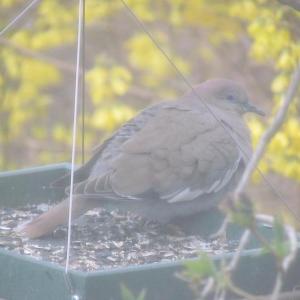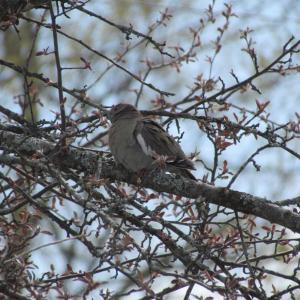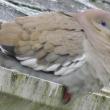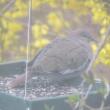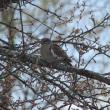White-winged Dove Wanders into Maine
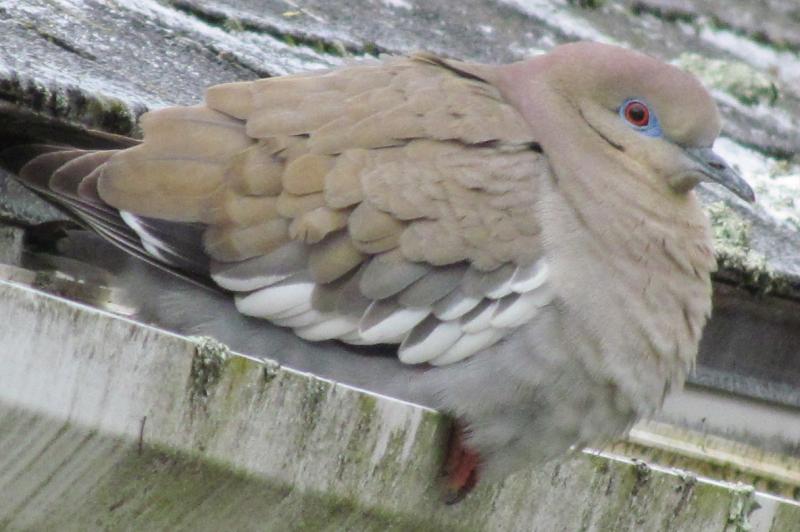 This past week, Maine had a rare visitor, a white-winged dove. This species normally occurs in southern Florida and the southwester U.S. Courtesy of Jeff Wells.
This past week, Maine had a rare visitor, a white-winged dove. This species normally occurs in southern Florida and the southwester U.S. Courtesy of Jeff Wells.
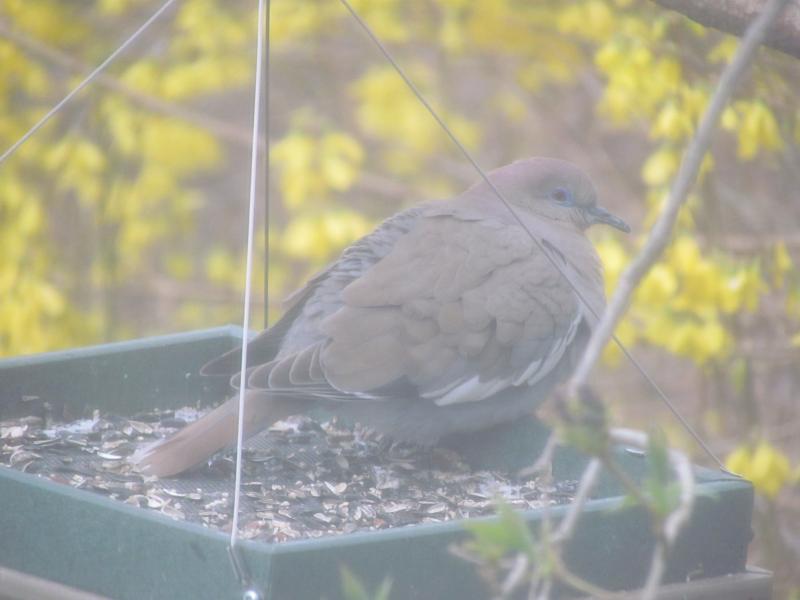 The white-winged dove at the authors’ backyard feeder. This species is increasing in its U.S. breeding range and more vagrants are showing up across the country. Courtesy of Jeff Wells.
The white-winged dove at the authors’ backyard feeder. This species is increasing in its U.S. breeding range and more vagrants are showing up across the country. Courtesy of Jeff Wells.
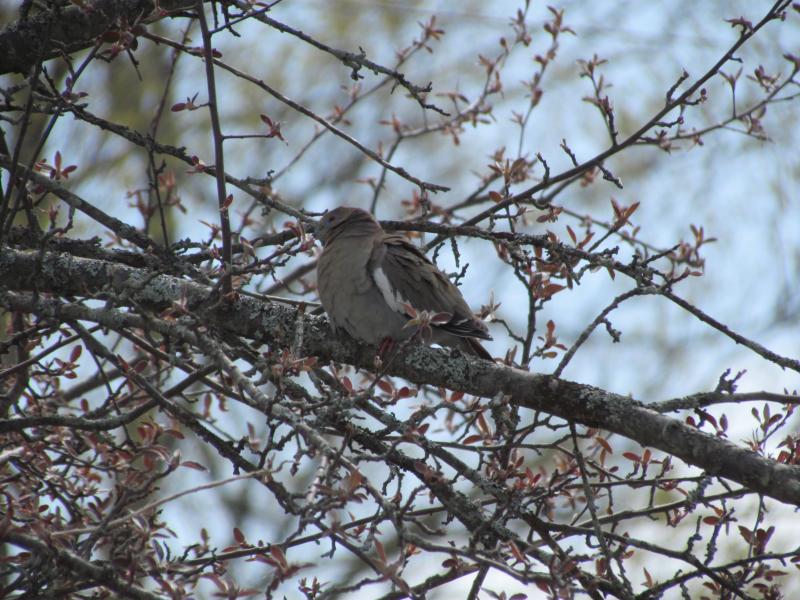 The authors awoke to the song of an unfamiliar-sounding dove perched in the apple tree outside their bedroom window. The tree was a favorite perch throughout the dove’s visit. Courtesy of Jeff Wells.
The authors awoke to the song of an unfamiliar-sounding dove perched in the apple tree outside their bedroom window. The tree was a favorite perch throughout the dove’s visit. Courtesy of Jeff Wells.
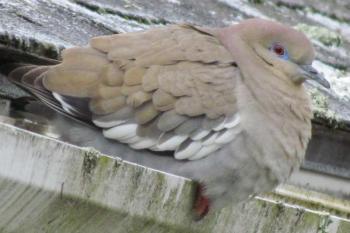 This past week, Maine had a rare visitor, a white-winged dove. This species normally occurs in southern Florida and the southwester U.S. Courtesy of Jeff Wells.
This past week, Maine had a rare visitor, a white-winged dove. This species normally occurs in southern Florida and the southwester U.S. Courtesy of Jeff Wells.
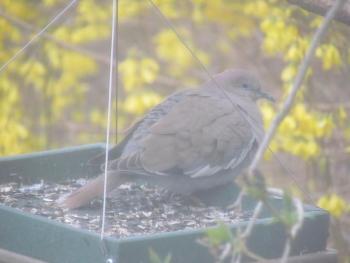 The white-winged dove at the authors’ backyard feeder. This species is increasing in its U.S. breeding range and more vagrants are showing up across the country. Courtesy of Jeff Wells.
The white-winged dove at the authors’ backyard feeder. This species is increasing in its U.S. breeding range and more vagrants are showing up across the country. Courtesy of Jeff Wells.
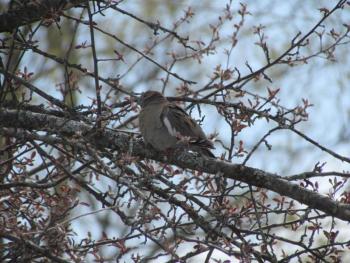 The authors awoke to the song of an unfamiliar-sounding dove perched in the apple tree outside their bedroom window. The tree was a favorite perch throughout the dove’s visit. Courtesy of Jeff Wells.
The authors awoke to the song of an unfamiliar-sounding dove perched in the apple tree outside their bedroom window. The tree was a favorite perch throughout the dove’s visit. Courtesy of Jeff Wells.
For years we had been saying to each other, “When will it be our turn to find a rare bird in our backyard?”
Last week it finally happened.
A white-winged dove, a bird of the southwestern U.S. and southern Florida, appeared under our feeder!
Technically, our first indication of its presence was when we were awoken in the early morning hours on Tuesday by a strange dove song. It was repeated three times (at least after we were awake enough to be aware of it) and, while we did not immediately recognize what it was, we knew it didn’t sound like a normal mourning dove or rock pigeon. Both of these species sometimes call from the roof or nearby crabapple, or from telephone wires in the morning. Once we got outside to look around, there were only mourning doves in sight, and the odd dove sounds had ceased.
We started to wonder if we had somehow been fooled in our semi-awake state that morning by some kind of aberrant call of a hormone-fueled male mourning dove or rock pigeon. Throughout the day we kept an eye out the window but never saw anything unusual.
Then during the late afternoon on Wednesday, while on a lengthy work call, a glance out the window revealed a different-looking dove under the feeder. It was a bit bigger than a mourning dove and was square-tailed rather than the wedge-shape of the familiar species. Its most significant feature was the line of white along the edge of its folded wing. When it flew, this marking flashed as a bold white patch on the middle of the upper wing. Later we had a chance to get a closer view and could really appreciate the beauty of its powder blue skin patch around the reddish eye.
White-winged doves occur across Central America and Mexico, reaching their northern limits in southern Texas, New Mexico, Arizona, and California. In recent decades the species has expanded its range northward as far as Oklahoma, and numbers have shown an overall increase since 2000. Small numbers occur across the Gulf Coast states now as well. The species was apparently introduced into Florida and now occurs in southern Florida. White-winged doves also occur in the Bahamas and Greater Antilles, and are said to be expanding there as well. Individuals in the northern part of the range migrate south into Central America for the winter and return in the spring to breed.
Maine’s first documented white-winged dove was in 1973 but there have now been at least 40 records. Since 2000, at least one has been found almost every year somewhere in the state. This is part of a trend seen across the U.S. and Canada, with more and more vagrant white-winged doves appearing north of the breeding range. Individuals have made it as far north as Alaska and Newfoundland. Some have speculated that we will also see an expansion of the breeding range significantly northward if this trend continues.
A check of the white-winged dove species account in the new, comprehensive “Birds of Maine” book showed that most records of the species in the state have been in fall, though some have occurred in May and June—but none in April until our bird arrived. Ours might have been a migrant coming north who got caught up in a storm system and just kept going northward. Or perhaps it was an explorer, an individual driven by hormones or some other inner madness insisting it just keep going and going and going. Maybe its stop here in Maine and its morning singing was a test to see if it could find another adventurer of its kind to settle down with and start a new population in the strange world it found itself in this week.
Knowing this bird was one that other birders would want the opportunity to see, we let our neighbors know about the bird and that people with binoculars and cameras would likely be roaming the neighborhood to catch a glimpse of this fascinating wanderer. We announced its presence to the world on Thursday morning.
It proved a wonderful way to celebrate Earth Day. Birders arrived, and we got to socially meet some new ones. A few got to photograph the bird. But by Friday, when even more birders arrived in the neighborhood, the bird had apparently move on.
We have not seen or heard it again. Maybe it headed back south. Maybe it kept going northward. Either way, we hope it is out there somewhere, cooing away in some other neighborhood, looking for a new place and a new beginning.
Jeffrey V. Wells, Ph.D., is a Fellow of the Cornell Lab of Ornithology and Vice President of Boreal Conservation for National Audubon. Dr. Wells is one of the nation's leading bird experts and conservation biologists and author of the “Birder’s Conservation Handbook.” His grandfather, the late John Chase, was a columnist for the Boothbay Register for many years. Allison Childs Wells, formerly of the Cornell Lab of Ornithology, is a senior director at the Natural Resources Council of Maine, a nonprofit membership organization working statewide to protect the nature of Maine. Both are widely published natural history writers and are the authors of the popular books, “Maine’s Favorite Birds” (Tilbury House) and “Birds of Aruba, Bonaire, and Curaçao: A Site and Field Guide,” (Cornell University Press).
Event Date
Address
United States


